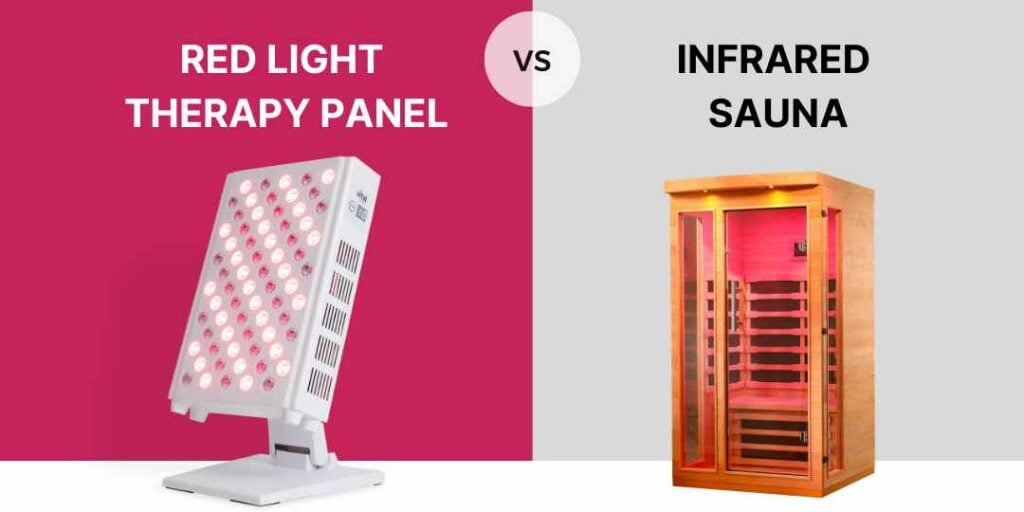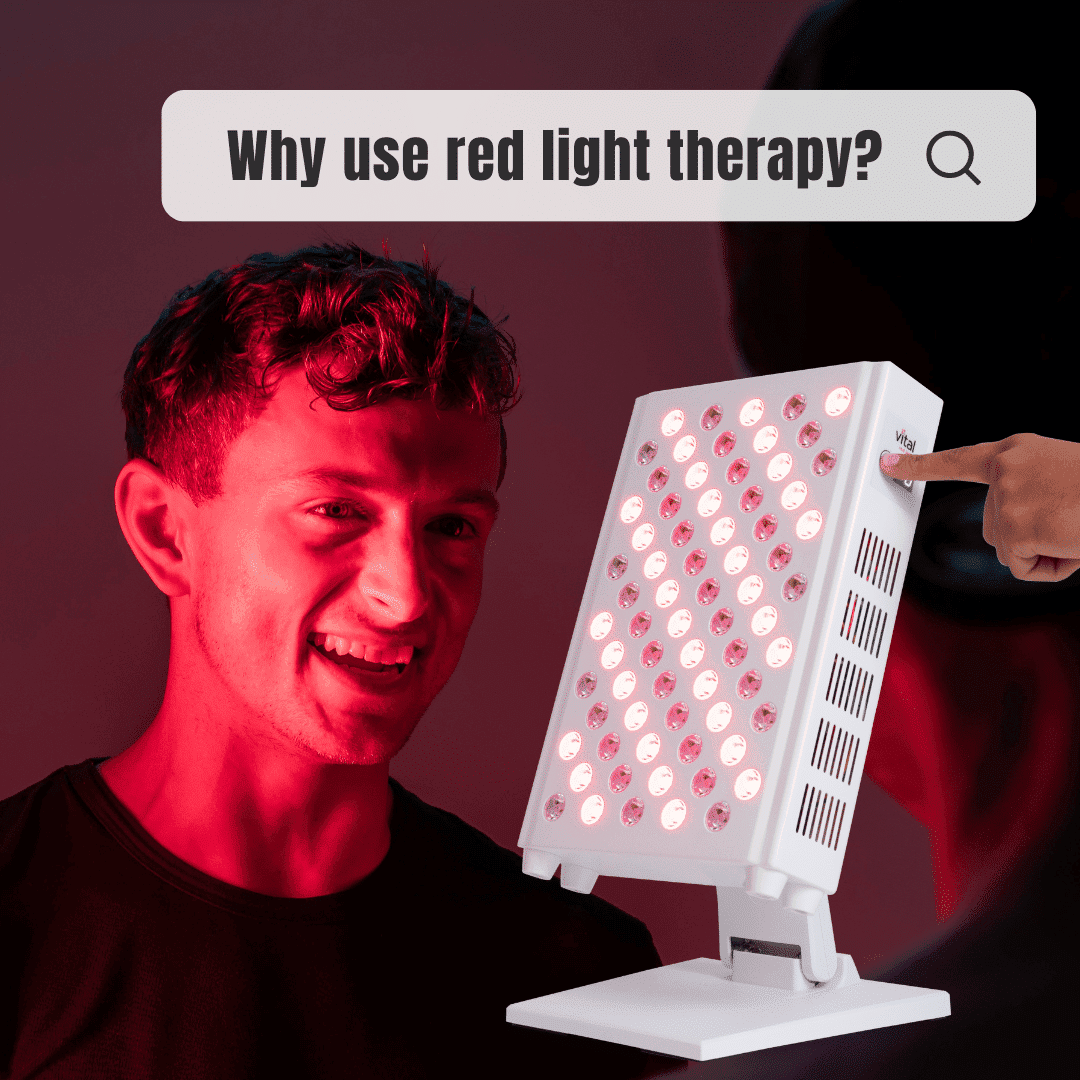- Jake Kreuz
- June 7, 2022
- Verified
Red Light Therapy vs. Infrared Sauna: What's the Difference?
We know you're a fan of saunas, and we are too. But what is the difference between red light therapy and infrared sauna? Well, it turns out they're both pretty awesome—and they work together really well. In this article we will break it down.

Introduction
Red light therapy and infrared saunas are two of the most popular wellness trends of the moment. Though both have been around for quite some time, a recent surge in the popularity of them has made it so that red light therapy and infrared saunas are popping up at spas, gyms, and even at home.
So what’s the hype all about? Why the sudden interest in red light therapy and infrared saunas? Because more and more studies have been emerging about the benefits they offer, including increased energy, reduced inflammation, better sleep, improved skin, and reduced stress levels. [1] Who wouldn’t want to get on board with that?
Although both technologies help improve your health in similar ways, there are some key differences between the two modalities. In this article, we’ll break down the major differences between red light therapy and infrared saunas, and show you how infrared saunas may be able to complement red light therapy.

The main difference: light vs. heat
Before we dive in any deeper, let’s start with the first and most important thing to understand about red light therapy vs. infrared saunas: they are different types of energy. Infrared saunas use an energy that is similar to traditional heat energy, while red light therapy uses light energy. What does this mean?
This means that infrared saunas and red light therapy machines work in different ways. Infrared saunas heat up the body directly by emitting infrared rays, while red light therapy works by targeting parts of your body with infrared light.
Infrared saunas vs. traditional dry saunas
You may have asked the question, “How is an infrared sauna different than a regular sauna?” or may now be wondering. We are here with the answer.
Infrared saunas heat the body from the inside out, whereas traditional saunas heat you from the outside in. Traditional saunas use steam to generate heat, while infrared saunas use infrared radiation, which heats your body directly without heating the air around you. [2] Infrared radiation is a form of thermal energy which means that it’s invisible to the naked eye but can be felt as heat. In an infrared sauna, far-infrared ceramic emitters generate this form of heat.
How infrared saunas work & the benefits
Infrared saunas use infrared heat instead of steam to provide deep-penetrating warmth and detoxification from within. While there are many different infrared sauna devices available, each type provides similar benefits: detoxification, improved circulation, better sleep, and pain relief.
Infrared saunas can help with arthritis, muscle spasms, injuries, chronic pain, and weight loss. [3] These wavelengths of light penetrate through the body and cause your core temperature to rise – which makes you sweat.
The main difference between infrared saunas and red light therapy
Red light therapy devices promote healing in similar ways to infrared saunas, but do so by using light beams (non-thermal light), instead of heat. These light beams are used to relieve pain and discomfort associated with muscle and joint stiffness, chronic pain relief, and other painful conditions associated with inflammation such as carpal tunnel.
In simple terms, saunas rely on heat to produce biological health benefits. Red light therapy, on the other hand, relies on light energy to produce a biological response.
Are infrared saunas backed by science?
The research on infrared sauna therapy is relatively new but promising. One study summarizes key findings on infrared saunas and states that they improve cardiac and vascular function as well as improve the quality of life in patients with type II diabetes. [4]
However, there is something very important to note about the majority of infrared saunas. Unfortunately, most of the red lights used in the leading brands of infrared saunas are not the medical-grade, therapeutic red lights that we use at Vital Red Light. Instead, they are something called chromotherapy.
While chromotherapy can be helpful, it is not the same as true red light therapy. This form of therapy serves much of the same purpose as traditional infrared therapy, by providing relaxation and reducing stress, among other benefits. [5]
Chromotherapy is a type of color therapy that uses different colors on the visible spectrum to treat different ailments. It’s been around since ancient times, and you can find it in yoga studios and other alternative healing settings today. The notion is that each color has a different effect on the body, with some being better for your digestive system and others for your circulatory system.
In this sense, red light therapy isn’t necessarily the best choice if you have issues with your digestive system—you’d want a blue or yellow light instead. Some people even use the concept of chromotherapy at home by taking baths with colored salts or by exfoliating with colored scrubs.
Some sauna companies like to market their saunas as having “red lights” when they really mean chromotherapy lights. That’s because the term “red light” is more well-known and sounds more appealing than “chromotherapy light.” Thus, more often than not, when you see something marketed as an infrared sauna, it is likely a chromotherapy sauna. Though chromotherapy does offer some great benefits, it is not the same as red light therapy.

The bottom line on infrared saunas
Infrared saunas have been used for decades by many cultures around the world to improve health. That’s because of their proven benefits, time and time again, that include things such as boosting circulation and increasing your body’s ability to sweat toxins out. This can lead to improved recovery after exercise or sore muscles.
However, you stand to gain the most benefits from using red light therapy in your infrared sauna sessions.
How red light therapy works & the benefits
Now that you understand more about infrared saunas, let’s chat about red light therapy. As mentioned above, infrared saunas emit heat and red light therapy emits light. This means that a sauna will heat your body up and a Vital Red Light will give your body light energy.
Red light therapy, also called photobiomodulation, works to target the body with very specific wavelengths of light that produce some powerful benefits. These benefits exist because red light (660 nm) is absorbed by your skin and near-infrared light (850nm) is able to penetrate through your skin and into your tissues, muscles, and body, where it can provide energy to the mitochondria of your cells to aid in all sorts of things. [6] Here are some of the top benefits you can get from red light therapy.
Skin health
Therapeutic red light treats the root cause of many skin issues by stimulating natural collagen production, reducing inflammation, and enhancing blood flow. Because of this, red light therapy can be used to help skin with anti-aging, fine lines & wrinkles, acne & acne scars, sunspots, and stubborn skin conditions such as eczema, rosacea, psoriasis, and sunspots.
Sleep
Red light therapy can help you relax and wind down in the evenings, ultimately promoting deeper and more restful sleep. This light has a long wavelength, which has a calming effect on the body. Therefore, red light therapy has beneficial effects on sleep and other physical properties that help promote relaxation and rest in the evenings while offsetting harmful blue light exposure during the days.
Muscle health
Many professional athletes are discovering the benefits of red and near-infrared light therapy. Because red light therapy works by increasing blood flow and stimulating cell regeneration, athletes are able to speed up the recovery process. Recent clinical studies have shown red and near-infrared light therapy can repair muscle, enhance athletic performance, and aid in the recovery process following a workout or injury. [7]
Mental health
Red light laser therapy can help eliminate fatigue (partially by working to support the thyroid), support a balanced mood, improve mental clarity, and improve general positivity while reducing anxiety, depression, and seasonal affective disorder (SAD).
Pain & inflammation
Red light therapy has shown immense potential as a natural treatment for pain and inflammation without the risks of pharmaceuticals. Red light therapy alleviates chronic inflammation by increasing blood flow and by increasing the body’s natural antioxidant defenses.
Circulation
Blood circulation is one of the most vital functions in the body. It’s how essential nutrients and oxygen get delivered to the brain and throughout the body. Red light therapy improves blood flow by stimulating the production of Nitric Oxide (NO) in our cells.
Is red light therapy backed by science?
There is study after study showing proof that red light therapy offers all of the benefits we mentioned above, and then some.
However, it is important to note that not all red light therapy is created equally. Many companies offering red light therapy do not use medical-grade red light, which will not provide the same benefits. In order to reap the benefits of red light therapy, you need medical-grade red light like the ones we use at Vital Red Light.
The bottom line on red light therapy
Red light therapy is a proven method to help with issues ranging from mental health to menstruation. The technology was originally developed by NASA in the 1980s to stimulate plant growth in the international space stations. Since then, more studies have been done to develop red light therapy for at-home use as well as additional benefits have been found through thousands of peer-reviewed trials and studies.
Using red light therapy to complement an infrared sauna session
Infrared saunas can be used in conjunction with red light therapy, but they can’t provide all of the same benefits as red light therapy. Thus, infrared saunas are not considered a replacement for red light therapy. It’s not really a “this or that,” but rather a “this and that.”
Keep in mind, however, that you shouldn’t take your Vital Red Light device into a sauna. Your red light therapy device is best used about five minutes after your sauna session. That’s because saunas deliver energy in different wavelengths, so they’re best used separately.
For the ultimate experience, spend 20 minutes in an infrared sauna to activate heat shock proteins in your body, increase your blood flow, and detox through sweat. Then, use your Vital Red Light device for 10-15 minutes to boost your cellular energy production, help with pain and inflammation, and support your sleep.
Both saunas and red light therapy devices are convenient and easy-to-use alternatives to more aggressive procedures that often require months of physical therapy to achieve the same level of pain relief, such as steroid injections, surgery, or extracorporeal shock wave therapy.
Conclusion
As you can see, there is a significant difference between red light therapy and infrared saunas and the benefits they provide.
Red light therapy uses light energy to heal, whereas infrared saunas use heat energy. They both offer unique modalities for treating all kinds of issues, including:
- Increased muscle mass and strength
- Better athletic performance
- Improved cognitive function
- Improved mood
- Better sleep
- Hair growth
Vital Red Light devices offer the visible red wavelength that you want and need to reap all the wellness benefits and get yourself to your best physical and mental place. Choose from our Vital Elite at-home panel that is big enough to reap benefits for your whole body in one sitting, our Vital Pro for targeted red light therapy, and our Vital Charge for your on-the-go red light therapy needs.
To start reaping the benefits of red light therapy today, check out our Vital Red Light devices to determine which one is best for you.
Citations
[1] Wunsch, Alexander, and Karsten Matuschka. “A controlled trial to determine the efficacy of red and near-infrared light treatment in patient satisfaction, reduction of fine lines, wrinkles, skin roughness, and intradermal collagen density increase.” Photomedicine and laser surgery vol. 32,2 (2014): 93-100. doi:10.1089/pho.2013.3616, https://www.ncbi.nlm.nih.gov/pmc/articles/PMC3926176/
[2] Brent A. Bauer, M. D. (2020, June 12). Do infrared saunas have any health benefits? Mayo Clinic. Retrieved May 11, 2022, from https://www.mayoclinic.org/healthy-lifestyle/consumer-health/expert-answers/infrared-sauna/faq-20057954
[3] Oosterveld, Fredrikus G J et al. “Infrared sauna in patients with rheumatoid arthritis and ankylosing spondylitis. A pilot study showing good tolerance, short-term improvement of pain and stiffness, and a trend towards long-term beneficial effects.” Clinical rheumatology vol. 28,1 (2009): 29-34. doi:10.1007/s10067-008-0977-y, https://pubmed.ncbi.nlm.nih.gov/18685882/
[4] Beever, Richard. “Far-infrared saunas for treatment of cardiovascular risk factors: summary of published evidence.” Canadian family physician Medecin de famille canadien vol. 55,7 (2009): 691-6., https://www.ncbi.nlm.nih.gov/pmc/articles/PMC2718593/
[5] Azeemi, Samina T Yousuf, and S Mohsin Raza. “A critical analysis of chromotherapy and its scientific evolution.” Evidence-based complementary and alternative medicine : eCAM vol. 2,4 (2005): 481-8. doi:10.1093/ecam/neh137, https://www.ncbi.nlm.nih.gov/pmc/articles/PMC1297510/
[6] Avci, Pinar et al. “Low-level laser (light) therapy (LLLT) in skin: stimulating, healing, restoring.” Seminars in cutaneous medicine and surgery vol. 32,1 (2013): 41-52, https://www.ncbi.nlm.nih.gov/pmc/articles/PMC4126803/
[7] Ferraresi, Cleber et al. “Photobiomodulation in human muscle tissue: an advantage in sports performance?.” Journal of biophotonics vol. 9,11-12 (2016): 1273-1299. doi:10.1002/jbio.201600176, https://www.ncbi.nlm.nih.gov/pmc/articles/PMC5167494/
Share
Download our FREE E-Book
Want to learn more? Download our official Red Light Therapy guide with over 1,214 clinical references on the power of Red Light Therapy.
Do you want to learn more?

Explore Related Articles
Red Light Therapy Morning Ritual
Why Use Red Light Therapy?
Red Light Therapy Benefits & How it Works

Explore Red Light Devices
Vital Pro is a targeted red and near-infrared LED light therapy device that improves skin health, promotes full-body wellness, and improves cellular health.









